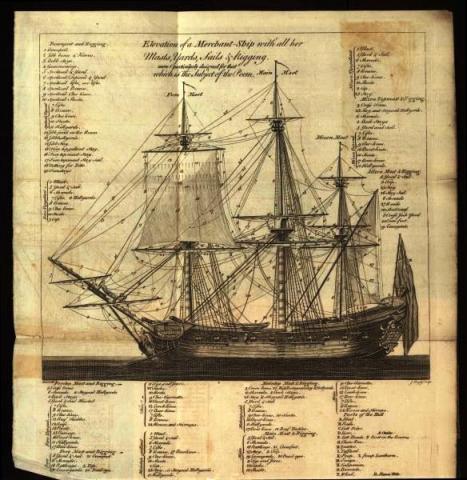
Essential Information
| Location |
National Maritime Museum
|
|---|---|
18 Jun 2011
William Falconer’s 'The Shipwreck' recounts the final voyage of the merchant ship Britannia and her crew.

The Shipwreck was first published in 1762 with Falconer ascribing authorship to 'a sailor'. Following its success, the second edition was published in 1764 and Falconer made considerable changes to the work, expanding this edition by over 1000 lines and enlarging the story with new scenes, descriptions and characters. Falconer’s final revision to the poem came in 1769 with the third edition, which was published before he joined the ill-fated frigate Aurora.
This poem is more than a work of pure fiction, however. The Shipwreck is firmly fixed in the everyday workings of a mid-18th century merchant vessel. Falconer was writing from personal experience and The Shipwreck is a semi-autobiographical work. Born in 1732, the son of a barber from Edinburgh, Falconer became a sailor and on a voyage from Alexandria to Venice (circa 1750) was one of only three survivors of the wreck of his vessel.
Falconer brings his personal experience not only of the horrors of a shipwreck but also of the management of a merchant vessel and The Shipwreck is partially intended as an instructional piece for sailors.The delightful fold-out plate provides a detailed diagrammatic glossary of a typical merchant vessel and its rigging, many parts of which are referenced within the poem. The text of the poem itself also contains technical details of sailing and navigation. Through the latter parts of the first canto, Falconer describes the departure from port and the sails used:
The swelling stu’n-sails now their wings extend,
Then stay-sails sidelong to the breeze ascend:
While all to court the wandering breeze are plac’d;
With yards now thwarting, now obliquely brac’d.
[Canto One, ll. 825-828]
Throughout the poem, Falconer uses footnotes to explain such technical detail to the reader. In this case, we are informed that at line 825 studding sails are 'long narrow sails that are only used in fine weather and fair winds, on the outside of the larger square sails'. Setting instructional detail like this to verse makes it memorable and enhances the didactic qualities of the poem.
The Shipwreck also contains a love story which touches upon emotions that many sailors’ families and loved ones left behind must have felt at the time. As Palemon, the Britannia’s youngest officer is parted from his love, Anna, 'She wept the terrors of the fearful wave,/ Too oft, alas! the wandering lover’s grave!' [Canto One, ll.677-8]
Anna’s fears are well founded and soon after leaving port, the Britannia is in difficulty. Canto Two describes the gathering storm that the ship encounters and the steps taken by the crew to try to save the ship: adjusting the course and the rigging, throwing the artillery overboard, and even cutting down the masts. The crew’s efforts are ultimately in vain and, in Canto Three, the ship is wrecked on the rocky Greek coast:
Again she plunges! Hark! A second shock
Tears her strong bottom on the marble rock!
Down on the vale of death, with dismal cries,
The fated victims shuddering roll their eyes,
In wild despair; while yet another stroke,
With deep convulsion, rends the solid oak.
[Canto Three, ll.640-645]
The destruction of the Britannia is also accompanied with vivid descriptions of the demise of members of the crew – some of whom attempt to climb to safety: 'Still on the rigging thirty seamen clung; / Some, struggling, on a broken crag were cast'. [Canto Three ll. 659-660]
The fourth edition of The Shipwreck is the first edition of the poem to be published after Falconer’s death, caused – with seeming inevitably – by a shipwreck. Falconer was appointed purser onboard the frigate Aurora in 1769 when it was lost after rounding the Cape of Good Hope. An introduction to a 1798 edition of Falconer’s works supposes the loss was caused by the Aurora taking fire after rounding the Cape.
One is left to wonder what the final moments of the Aurora must have been. With the example of The Shipwreck, perhaps Falconer offers us all the opportunity to imagine this with a little more clarity.
Find out more about shipwrecks using the Library collection. We have a range of resources covering shipwrecks around the British Isles, including The Shipwreck Index of the British Isles and British Warship Losses in the Age of Sail, 1690–1859.
Gareth, Reader Services Librarian